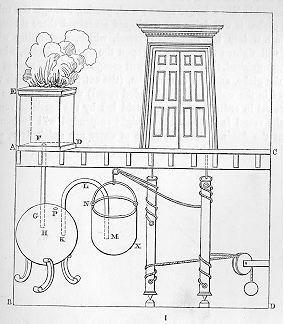The construction of a small temple such that, on lighting a fire, the doors shall open spontaneously, and shut again when the fire is extinguished.
 Let the proposed temple stand on a pedestal, A B C D
(fig. 37), on which lies a small altar, E D. Through the altar insert a
tube, F G, of which the mouth F is within the alter and the the mouth G
is contained in a globe, H, reaching nearly to its centre: the tube must
be soldered into the globe, in which a bent siphon, K L M, is placed.
Let the hinges of the doors be extended downwards and turn freely on
pivots in the base A B C D; and from the hinges let two chains, running
into one, be attached, by means of a pulley, to a hollow vessel, N X,
which is suspended; while other chains, wound upon the hinges in an
opposite direction to the former, and running into one, are attached, by
means of a pulley, to a leaden weight, on the descent of which the doors
will be shut. Let the outer leg of the siphon K L M lead into the
suspended vessel; and through a hole, P, which must be carefully closed
afterwards, pour water into the globe enough to fill one haif of it. It
will be found that, when the fire has grown hot, the air in the altar
becoming heated expands into a larger space; and, passing through the
tube F G into the globe, it will drive out the liquid contained there
through the siphon K L M into the suspended vessel, which, descending
with its weight, will tighten the chains and open the doors. Again,
when the fire is extinguished, the rarefied air will escape through the
pores in the side of the globe, and the bent siphon, (the extremity of
which will be immersed in the water in the suspended vessel) will draw
up the liquid in the vessel in order to fill up the void left by the
particles removed. When the vessel is lightened the weight suspended
will preponderate and shut the doors. Some in place of water use
quicksilver, as it is heavier than water and is easily disunited by fire.
Let the proposed temple stand on a pedestal, A B C D
(fig. 37), on which lies a small altar, E D. Through the altar insert a
tube, F G, of which the mouth F is within the alter and the the mouth G
is contained in a globe, H, reaching nearly to its centre: the tube must
be soldered into the globe, in which a bent siphon, K L M, is placed.
Let the hinges of the doors be extended downwards and turn freely on
pivots in the base A B C D; and from the hinges let two chains, running
into one, be attached, by means of a pulley, to a hollow vessel, N X,
which is suspended; while other chains, wound upon the hinges in an
opposite direction to the former, and running into one, are attached, by
means of a pulley, to a leaden weight, on the descent of which the doors
will be shut. Let the outer leg of the siphon K L M lead into the
suspended vessel; and through a hole, P, which must be carefully closed
afterwards, pour water into the globe enough to fill one haif of it. It
will be found that, when the fire has grown hot, the air in the altar
becoming heated expands into a larger space; and, passing through the
tube F G into the globe, it will drive out the liquid contained there
through the siphon K L M into the suspended vessel, which, descending
with its weight, will tighten the chains and open the doors. Again,
when the fire is extinguished, the rarefied air will escape through the
pores in the side of the globe, and the bent siphon, (the extremity of
which will be immersed in the water in the suspended vessel) will draw
up the liquid in the vessel in order to fill up the void left by the
particles removed. When the vessel is lightened the weight suspended
will preponderate and shut the doors. Some in place of water use
quicksilver, as it is heavier than water and is easily disunited by fire.